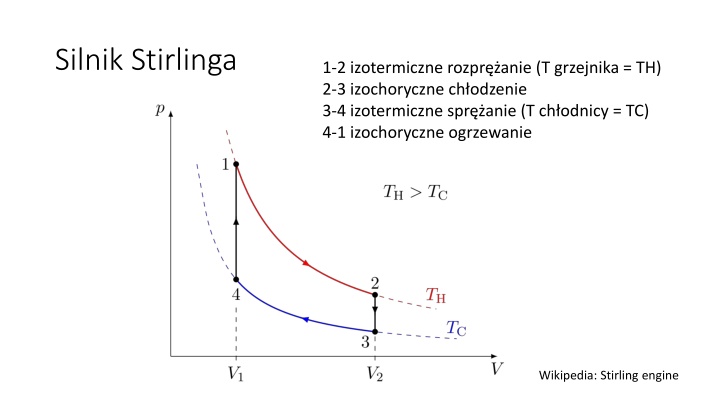
The Stirling Engine Cycle
Explore the Stirling engine cycle, including the idealized processes: isothermal expansion, constant-volume heat removal, isothermal compression, and constant-volume heat addition. Learn about the different types of Stirling engines, such as Alpha-type and Beta-type, and how they operate to convert heat into work efficiently. Discover the role of regenerator and regenerative heat exchangers in enhancing the thermal efficiency of Stirling engines.
Download Presentation

Please find below an Image/Link to download the presentation.
The content on the website is provided AS IS for your information and personal use only. It may not be sold, licensed, or shared on other websites without obtaining consent from the author. If you encounter any issues during the download, it is possible that the publisher has removed the file from their server.
You are allowed to download the files provided on this website for personal or commercial use, subject to the condition that they are used lawfully. All files are the property of their respective owners.
The content on the website is provided AS IS for your information and personal use only. It may not be sold, licensed, or shared on other websites without obtaining consent from the author.
E N D
Presentation Transcript
Silnik Stirlinga 1-2 izotermiczne rozpr anie (T grzejnika = TH) 2-3 izochoryczne ch odzenie 3-4 izotermiczne spr anie (T ch odnicy = TC) 4-1 izochoryczne ogrzewanie Wikipedia: Stirling engine
1. Pyn roboczy (np. powietrze) pozostaje zamknity nie ma wydechu 2. Silnik wytwarza ma o ha asu 3. W niekt rych modelach u ywany jest tzw. regenerator czyli zbiornik ciep a Alpha-type Stirling engine. There are two cylinders. The expansion cylinder (red) is maintained at a high temperature while the compression cylinder (blue) is cooled. The passage between the two cylinders contains the regenerator Wikipedia: Stirling engine
Beta-type Stirling engine, with only one cylinder, hot at one end and cold at the other. A loose-fitting displacer shunts the air between the hot and cold ends of the cylinder. A power piston at the open end of the cylinder drives the flywheel Wikipedia: Stirling engine
The idealised Stirling cycle consists of four thermodynamic processes acting on the working fluid: 1.Isothermal expansion. The expansion-space and associated heat exchanger are maintained at a constant high temperature, and the gas undergoes near-isothermal expansion absorbing heat from the hot source. 2.Constant-volume (known as isovolumetric or isochoric) heat-removal. The gas is passed through the regenerator, where it cools, transferring heat to the regenerator for use in the next cycle. 3.Isothermal compression. The compression space and associated heat exchanger are maintained at a constant low temperature so the gas undergoes near- isothermal compression rejecting heat to the cold sink 4.Constant-volume (known as isovolumetric or isochoric) heat-addition. The gas passes back through the regenerator where it recovers much of the heat transferred in process 2, heating up on its way to the expansion space. The engine is designed so the working gas is generally compressed in the colder portion of the engine and expanded in the hotter portion resulting in a net conversion of heat into work.[2]An internal regenerative heat exchanger increases the Stirling engine's thermal efficiency compared to simpler hot air engines lacking this feature. Wikipedia: Stirling engine






















